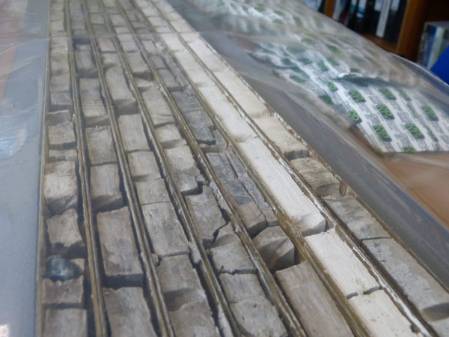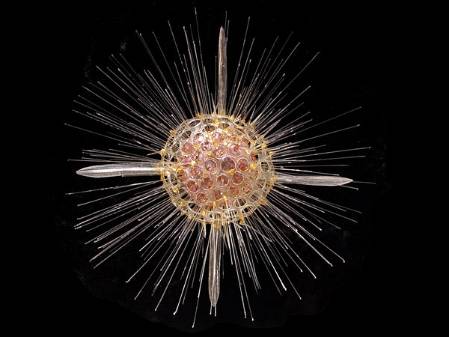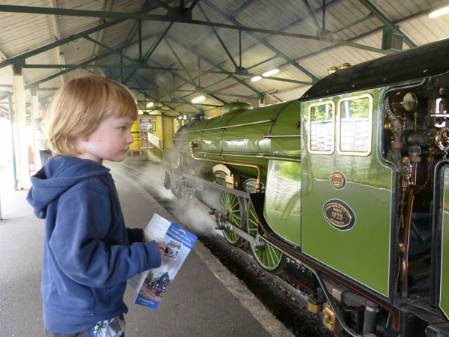This week I celebrate 20 years at the Museum, and my diary has included preparing for a researchers' night highlighting museum science, Tweeting as part of #AskaCurator day and visiting a miniature steam railway.
Monday
Most of today has been spent preparing for Science Uncovered, our EU-funded researchers' night on Friday 27 September. The doors of the Museum will remain open after usual closing time and scientists like myself will be available to talk about our science, show specimens and chat. Presentations in the Nature Live Studio will also be held and it will be possible to book tours to areas of the Museum not normally open to the public.
This core from the Atlantic SW of Ireland represents the last major glacial period showing glacial dropstones from colder periods (left) and white sections composed almost entirely of warm water microfossils (right). The green packets and plastic sleeve maintain an oxygen free environment.
We are showing some deep sea cores taken from the Atlantic Shelf off SW Ireland through sediment that was deposited during the last glaciation. It's a great opportunity to show the key role micropalaeontology plays in quantifying and dating past climatic episodes. The core relates to periods when icebergs broke off glaciers and traversed the North Atlantic.
Tuesday
A major part of my job is dealing with enquiries about our microfossil collections and subsequently hosting visits or preparing loans. Two main collections are our most requested, the Challenger Foraminifera and the Blaschka glass models of radiolarians. Since three specimens from our Blaschka collections have been on display in our Treasures Gallery, we have had an increased number of enquiries and visitors to view the other 180 specimens that are not currently on display.
Image of one of our Blaschka glass radiolarian models that was widely retweeted during #AskACurator day.
Today we are showing the undisplayed Blaschka collection to an artist, last week it was a glassworker from Imperial College and later this week it is a photographer hoping to create a book of images from Blaschka collections across Europe.
Wednesday
I have spent virtually the whole day on Twitter monitoring questions and providing answers as part of #AskACurator day. Fellow curators from over 500 different museums and 35 different countries have been fielding questions over Twitter causing the hashtag to trend. At one stage it was globally the second most discussed subject on Twitter.
I answered questions like:
'Do you require a masters degree to become a curator?'
'Which museum, other than your own, inspired you recently?' (the Foraminiferal Sculpture Park in China)
'Which specimens in your collection give you goosebumps when you see them?' (Blaschka glass models)
'What sparked your interest to become a curator?'
'Do you need to be an obsessive to be a curator?'
'Which specimen not currently on display would you like to see being displayed?' (100 year old microfossil Christmas card).
Many of the questions I was able to expand on using links to blog posts, particularly the one entitled 'How to become a curator'. I started to reply to the 'what is a curator?' question but could not cram 'someone who cares for a collection by enhancing its documentation and storage, maintains access to it by facilitating loans, visits and exhibits and promotes its relevance by engaging with potential users' into 140 characters.The day certainly showed what a varied job we all have, how passionate we are and that one day is never the same as another.
Thursday
My colleague Steve has worked out that we had 65 new interactions (messages, favourites, retweets, new followers) during #AskACurator day yesterday as well as some more hits to this blog. However, I am saddened as I read a well known museums blog that says that the best way to reach a wide audience is to avoid niche subjects like micropalaeontology and links direct to my blog as an example. It starts me wondering if accumulating vast numbers of hits really show that a blog is successful?
A string of meetings are scheduled too; we are applying for funding for a major 3 year conservation project, the photographer arrives to discuss his project and we are finishing an application to hire a new PhD project studying traits of evolution. Microfossils are extremely useful as their fossil record is relatively complete compared to other fossil groups and collections can be made relatively easily across large geographical areas.
Friday
Earlier in the week I got to work to find two of my train mad, three year old son Pelham's Thomas the Tank Engine stickers on my socks. On Monday he is starting nursery school so today we are taking him and his younger sister Blossom to one of our favourite places, the Romney, Hythe and Dymchurch Railway in Kent. I feel that this family day is a suitable way to celebrate the 20th anniversary of my arrival at the Museum as a volunteer.





